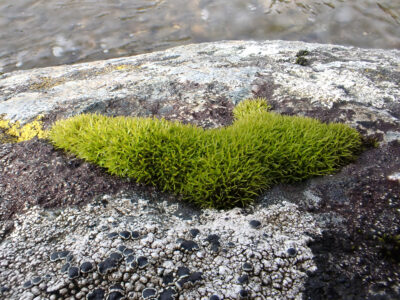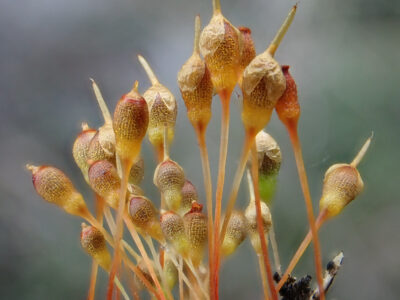
The Glos local group was pleased to find this species on a recent meeting in the Forest of Dean. It can be difficult to tell from the more common P. asplenioides and P. porelloides, but its habit - growing in loose mats - and leaf shape gave this one away. On close inspection, the cells looked a little larger too, but that needed confirming under the microscope.
View more
One of the many beautiful liverworts seen on the recent BBS Liverwort Workshop in Kinlochewe. This lovely photo was taken by Philippa Thompson.
View more
I'm not sure what this Marchantia was looking at, surely the photographer wasn't that scary!!!
View more
This rather rare oceanic liverwort was seen on the banks of the Claggain river during the recent Summer meeting on Islay. It is large and differs from other thallose liverworts also found in this habitat by having no air pores on its surface, and having bristly hairs along the thallus margins - so there should be no problem identifying it if you are lucky enough to see it!
View more
The common name for this moss is Yellow-bud Grimmia, presumably because of the yellowish clusters of gemmae on many of the shoot tips (which you might be able to make out on the left side of this cushion). This photo was taken during the Ben Lawers meeting in autumn 2023, on a loch-side boulder at Coire nan Cat - a typical habitat for this species.
View more
This beautiful close-up of a shoot of Mylia taylorii, taken by Wouter van Landuyt from a specimen collected on Islay, shows the recurved leaves and large cells beautifully. To say that I'm envious of the microscope Wouter used to take this photo would be an understatement!
View more
Spotted by David Long on the recent BBS summer meeting on Islay. This specimen is growing with a confusing mixture of other liverworts, including Aneura pinguis, a Riccardia and a Jungermannia (at least!). These are female plants, with young, frilly-looking perianths.
View more
Previously known as Preissia quadrata, or Narrow Mushroom-headed Liverwort. This image shows immature female receptacles, each of which can have up to 8 sporophytes which develop inside a protective involucre. This specimen was growing in crevices in a wall at Visegrád Castle near Budapest in Hungary.
View more
One of the many beautiful bryophytes seen on the recent meeting in Hungary. This species was growing in saline grassland at Apaj, and was obviously very happy. Thank you to Peter Erzberger for arranging the meeting, and shepherding our group of around 20 errant bryologists around some of the most interesting sites in the region of Budapest without losing anyone (or his temper)!
View more
Bryophytes really repay a little more study - they are not just beautiful in the field! Here you can see the antheridia (male organs) of Hypnum cupressiforme in various stages of development. To observe these, you need to find a shoot with diminutive male side branches, then just dissect one of these, removing all the subtending bracts. This specimen was collected in January, but antheridia may not be present throughout the whole year; we don't know a great deal about the timing of sexual reproduction stages for many bryophytes species.
View more